
Enterprise Email Marketing Strategy Guide For 2025
Enterprise marketing has always focused on growth and customer relationship-building strategies. One of these tactics is enterprise email marketing, a strategy that can help you nurture, convert, and retain your customers. If you still haven’t leveraged the power of email for your large business, it’s time you did.
Today, we’ll see how to create a high-performing email marketing strategy for enterprises. More specifically, in this guide, you’ll learn:
- The benefits of email for your business
- How to choose the right email marketing software
- What email campaigns to send, and more
- Why you need marketing automation
Now let’s start by taking a look at the advantages that email offers to large business owners.
Benefits Of Email Marketing For Enterprises
Email is a very versatile channel of communication that you can use to keep in touch with your customers. While you may think that this is the only thing email offers, the channel also:
- Has the best return on investment, $42 for every $1 spent on it
- Amplifies your relationship marketing efforts
- Boosts your brand awareness
- Delivers personalized content through segmentation
- Generates website traffic and boosts sales
These are only a few of the benefits of email marketing. Email is a powerful marketing tool to nurture your audience through a channel they know well. Creating the right campaign to target it is essential to reap the benefits and power up your enterprise.
Moreover, while you may have an extended customer base, keeping it engaged will differentiate you from your competitors and make your business last in time.
How To Create Your Enterprise Email Marketing Strategy
Now that you have an idea of what you and email can accomplish let’s take a look at the steps you need to implement your email strategy:
- Get an advanced email marketing tool
- Start building your email list
- Segment your target audience
- Personalize your email campaigns
- Create valuable subject lines
- Choose the right email newsletters
- Automate your marketing process
Without further ado, let’s dive right into them!
1. Get An Enterprise Email Marketing Service
Choosing the right tools is necessary to avoid getting software that will be a bad fit for your large business. Your email strategy needs an advanced ally to help you automate your process.
Also, enterprise-level software needs to offer you all-in-one functionality to capture, nurture, and convert your email subscribers. Below, you will find the best features an email marketing solution needs to have. Let’s see:
- Advanced Email Builder: a drag-and-drop editor with advanced features and a friendly user interface to create converting email designs.
- Email Marketing Automation: build automated workflows to streamline your process. Use personalization to deliver more relevant content and experiences.
- Email Deliverability: make sure that your emails will reach your recipients’ inbox every single time and maintain a good sender score.
- Email List Management: use segmentation to group your audience for better management and engagement.
- Integrations: combine your favorite marketing tools with your email software for better results.
- Advanced Reporting: create custom reports and track important metrics to optimize your strategy.
- Account Management and Customer Support: to help you get the most out of your service, solve problems and address your needs.
The above email marketing features are some of the most important things you need to search for when you choose a platform. Now that you know them, let’s check some tools you can use to get started.
Best Enterprise Email Marketing Platforms
Below, you’ll find three of the top email marketing tools that offer advanced functionality and an array of tools. The market offers a plethora of popular platforms to choose from, like Mailchimp, Marketo, Constant Contact, and Brevo (formerly Sendinblue). Nevertheless, since your business will pick a plan based on the number of subscribers you have, we found the best services to get all the advanced functionality you need.
Here they are:
Moosend – All-in-One Email Marketing Tool
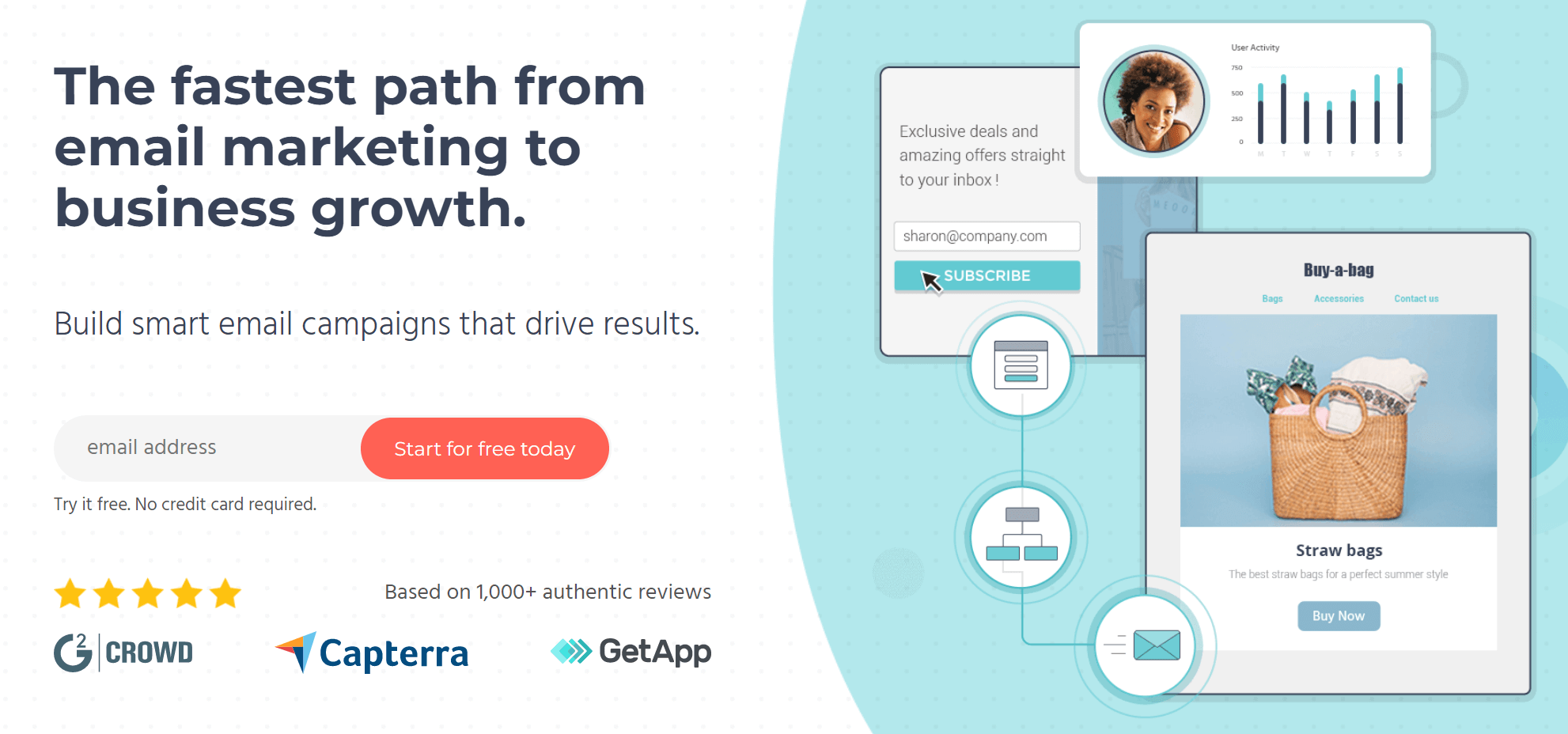
Moosend’s email marketing automation platform has all you need to set your enterprise email strategy in motion. Among others, the service offers a user-friendly drag-and-drop email editor, a visual workflow builder, autoresponders, online forms, landing pages, and audience management tools.
More specifically, you can use the advanced elements to create converting HTML email marketing campaigns from scratch or select one of the available email templates to save time. The forms and landing page builders will let you boost your lead generation and power up your segmentation and personalization efforts later on.
When it comes to marketing automation, you can easily create a variety of automated workflows like onboarding, engagement, and cart abandonment sequences for your large eCommerce business. The reporting and A/B testing tools will also power up your optimization efforts. Account management, real-time reporting, and native integrations (Salesforce, etc.) -or through API- are also available to help your sales and marketing teams.
Pricing: Moosend offers scalable pricing starting at $315/mo for 50K subscribers. For more, you can get the Enterprise Plan by requesting a custom quote. The Custom plan gives you access to custom reporting, the Account Manager, team members, and more. You can also try Moosend for free by signing up for an account.
HubSpot – Email Platform with CRM Capabilities

HubSpot is another great tool you can use to help your enterprise move towards success. More specifically, the ESP is popular for its Customer Relationship Management (CRM) system that allows you to keep track of your contacts’ information. Then you can use it to personalize the customer experience with targeted email messages.
To craft your campaigns, you can take advantage of the pre-built email newsletter templates to save time or use the email editor to create one from scratch. Apart from its contact list management tool, HubSpot also equips you with smart automated workflows and custom autoresponders to target your audience the moment they need it.
And to help you with lead generation, the platform offers additional tools like a landing page builder and online forms to boost your enterprise email marketing efforts.
Pricing: HubSpot offers a free plan and three paid subscriptions, Starter, Professional, and Enterprise. The Professional starts at $890/mo for 2,000 contacts for the marketing hub, while the Enterprise starts at $3,200/mo for 10,000 contacts.
ActiveCampaign – Advanced Marketing Automation Tool
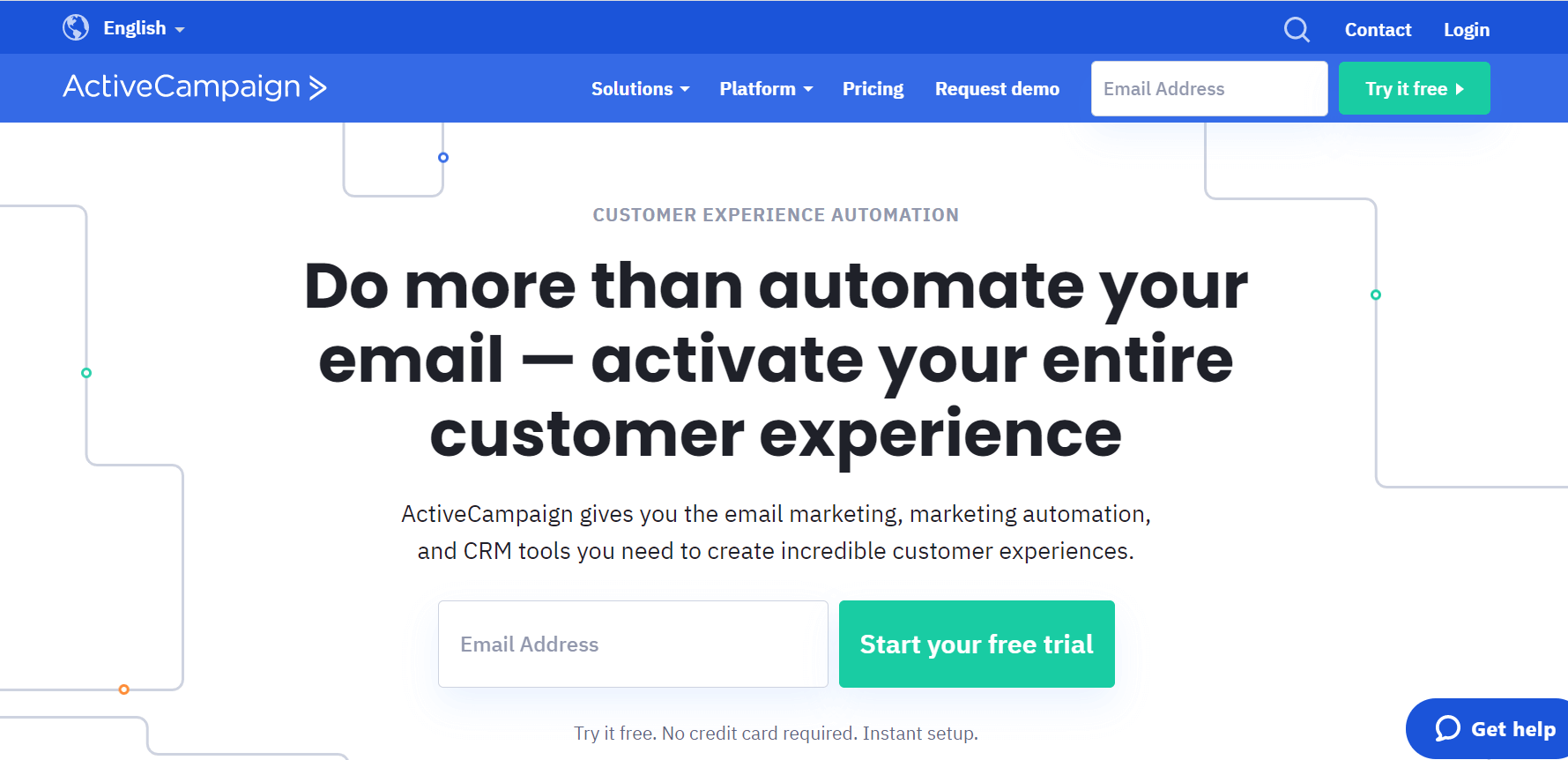
ActiveCampaign is famous for its advanced marketing automation capabilities, which make it an ideal choice for experienced email marketers. When it comes to campaign creation, you can use the email builder to craft beautiful designs or choose one of the available templates.
Back to the automation tools, ActiveCampaign will give you advanced features to create complex sequences for your audience. To get the most out of them, though, you need to be familiar with them; otherwise, the software may be difficult to handle.
Apart from that, you can leverage the ESP’s event tracking functionality to monitor your subscribers’ activity and collect data to personalize their experience. Lastly, you can benefit from the built-in CRM system to simplify your sales process.
Pricing: ActiveCampaign has numerous paid plans. The Professional starts at $686/month for up to 25K subscribers, whereas you need to contact sales to get a custom quote for the Enterprise version. The service also has a free trial to try it out.
Now that you find out the best email service providers for your enterprise, let’s move on to the next step.
2. Start Building Your Mailing List
Compared to small businesses, your enterprise has a major advantage: you already have a large target audience visiting your website. So you can leverage that to build your email lists.
For AT&T, using a newsletter signup form is a great idea to get your website visitors to give you their email addresses.
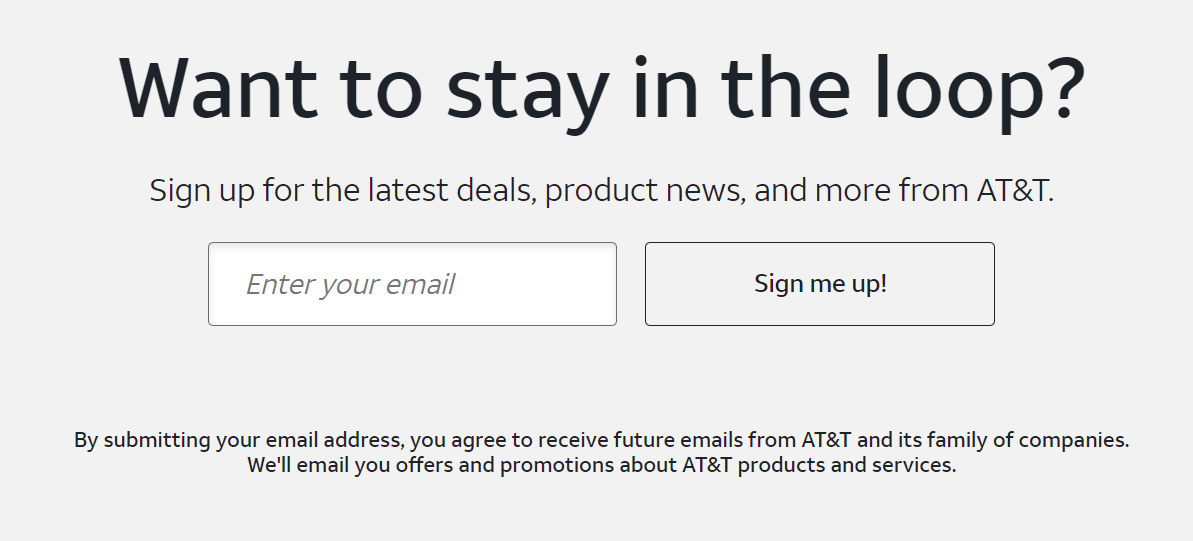
As you can see, this embedded form is very simple. Here’s what works:
- It has a heading in question format to attract attention
- The form copy highlights the benefits of joining
- The micro-copy supports the main message by offering extra details
When it comes to the call-to-action, the business could have chosen a bright color to increase its visibility and promote its signup rate. Apart from online forms, you can also boost your lead generation efforts through landing pages. As you know, these individual pages are usually connected to social media ads. So make sure to create a value proposition that will show your potential subscribers why they should give you their address.
Keep in mind that subscribers are more likely to hand it to you if you give them something in return, i.e., lead magnets. For example, you can provide them with discounts or free shipping if you are in the eCommerce space, or with checklists and guides if you have a SaaS company.
Whatever you choose, make sure to stress out the benefit of joining your list. Now, let’s move on to another important tactic you need to know about.
3. Segment Your Target Audience
As you understand, the one-size-fits-all messages of the past no longer work. Customers now expect businesses to deliver personalized content that will provide viable solutions to their problems. So, mass emailing your audience is a bad practice that will yield no results.
To avoid that, you have to embrace email segmentation, a practice that aims to divide your email subscribers into smaller groups based on specific criteria. For example, you can segment your audience based on their age and gender, profession, or location to target them more effectively.
Segmentation isn’t a difficult process but to perform it effectively, you need data. The best way to get them is through your newsletter signup forms. Here’s an example from Samsung’s Newsroom newsletter:
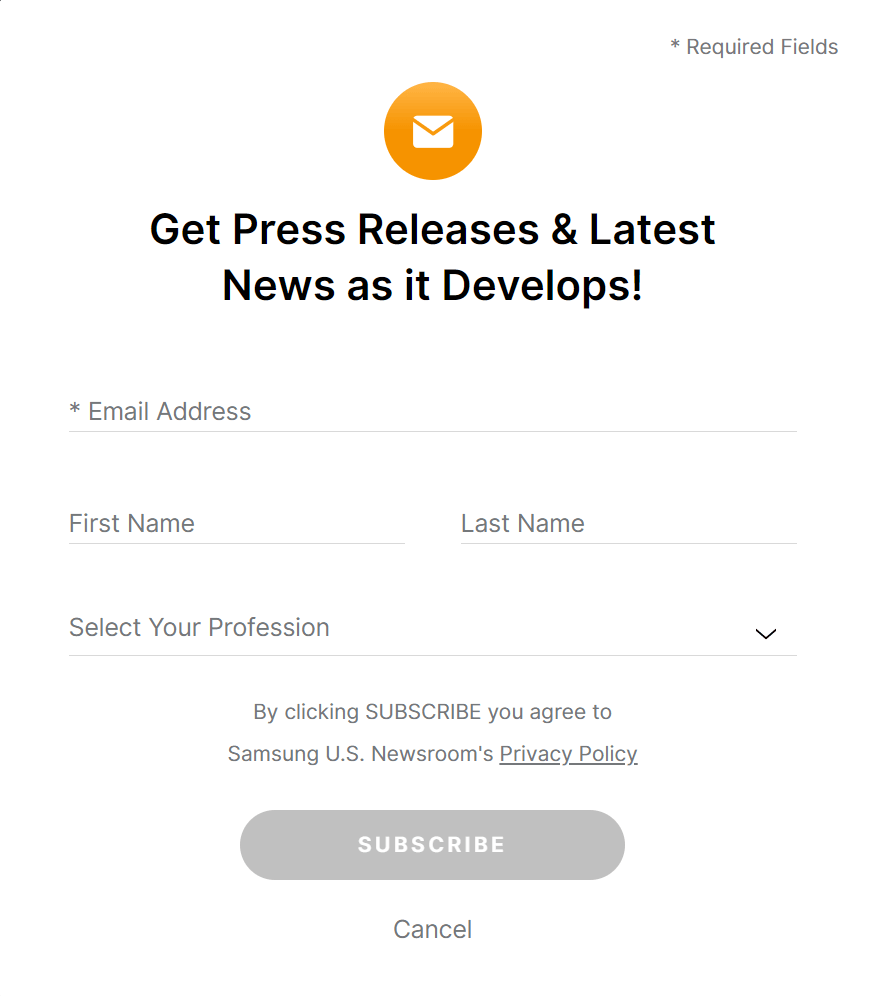
Compared with AT&T’s form, Samsung has included three additional form fields to capture the visitors’ names, surnames, and professions.
When they subscribe, the company will segment them based on the information they provided and start another equally important process called email personalization. Let’s find out more about it below.
4. Personalize Your Enterprise Email Marketing Campaigns
As an enterprise with a large audience, your customers may think that everything you send them isn’t tailor-made for them. So how do you warm them up?
Email personalization is the answer to better and more engaging email marketing campaigns. Nevertheless, to take advantage of it, you need to know some basic information about your subscribers. For example, if your target audience consists of different demographics, you can collect this info through your newsletter signup forms. Then, you can use the details to craft personalized messages for your audience.
The simplest form of personalization is to add a name in your subject lines or email content. However, if you want to take it one step further for maximal results, you can create dynamic content to show your audience exactly what they need.
For instance, you can display content based on your subscriber’s location, profession, or gender to boost engagement and minimize your unsubscribe rate.
So, how can you make this happen? After you collect your data, you can use your ESP’s advanced personalization options to create emails with conditional content. You can easily try Moosend’s email platform and check out the feature.
5. Create Valuable Subject Lines
Your email subject lines are the first touchpoint between your emails and your subscribers. So to get them to interact with your message, you need to make your copy valuable and intriguing enough.
Before you do that, make sure to avoid any spam words as they will hinder your email deliverability and harm your sender score. Creating effective email subject lines isn’t rocket science but you have to keep a few things in mind. Keep them short and on-point, use actionable language, urgency, and personalize them with a subscriber’s name.
Below, let’s check a few examples of efficient subject lines that will give you good open rates:
Welcome Emails
- Welcome! Your half-off deal is waiting… (CoSchedule)
- Welcome to Adobe Experience Cloud — we’re here to help (Adobe)
Company Updates
- Xara Cloud Update: Improved drag & drop, scrolling & more (Xara)
- Important Update: New Pricing Plans (Moosend)
Webinars
- How to attract more prospects through digital content (MarketingProfs)
- [Webinar] Level up your lead funnel with Zapier + Keap (Zapier)
Your subject lines are a big deal. So if you’re having trouble creating them, make sure to find useful tools to help you out. For instance, getting an AI subject line tester is a simple and effective solution to see what performs and use it to improve your open rates!
Set your Preview Text
Before we see the best enterprise email marketing campaigns you need to send, let’s take a look at your email preview text.
This extra line of copy, appearing next or under your subject line depending on your inbox provider (Gmail, Outlook, etc.), will give your subscriber additional details about your message.
Let’s take a look at the examples below:
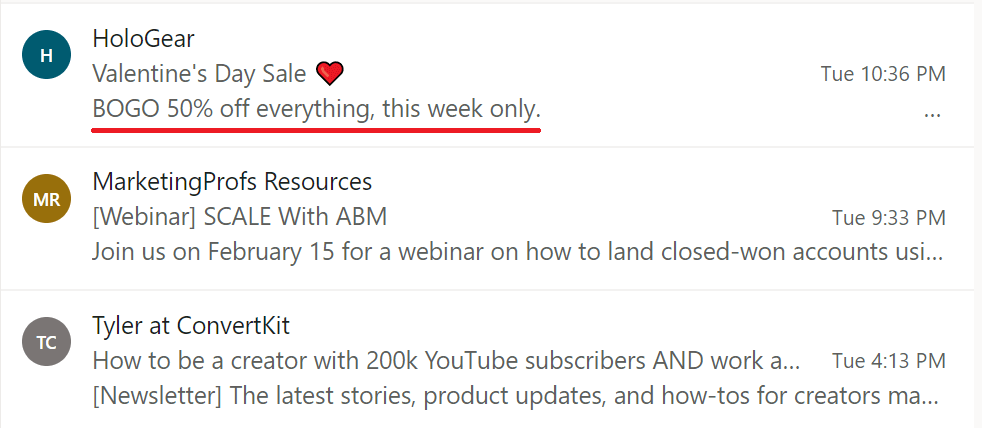
In the first one, HoloGear uses its preview text to support its Valentine’s Day Sale email. By giving the “50% off everything,” customers receive the immediate value of the campaigns and, thus, you can expect better open and click-through rates.
Similarly, MarketingProfs provides extra information about its upcoming webinar to intrigue and excite its audience. Your email preview text is a small yet powerful addition to your email marketing campaigns. So make sure to add one to power up your messages.
6. Choose The Right Email Newsletters
As an enterprise, you need to find the perfect combination of email marketing messages to boost your marketing and sales funnel. Consequently, you need to craft emails that will deliver value to your subscribers’ inboxes.
To do that, you first need to set your email marketing goals. Ask yourself, what do I need to do to welcome new subscribers? The answer is to create a friendly welcome sequence for them. And speaking of that, let’s start with a great welcome email newsletter example!
Welcome Emails
Subject line: Welcome to Designmodo! 🤗
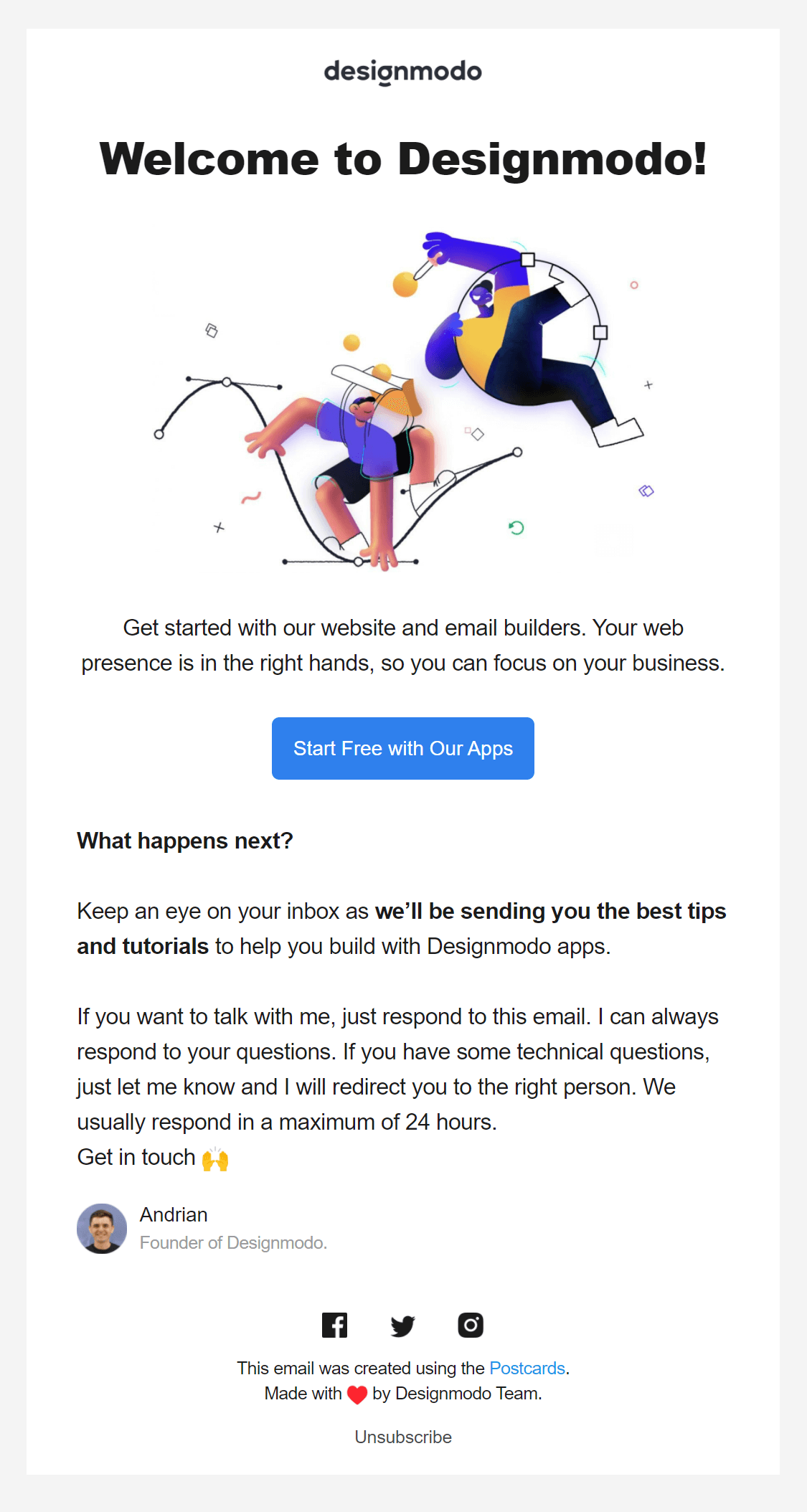
Designmodo’s welcome email is an example of a simple yet effective message. The business takes advantage of white space and bold visuals to make the email more readable and unique while staying true to its branding.
Moreover, the copy is short, giving new users an overview of what they can do after signing up. To lead them back to its webpage, Designmodo also adds a blue call-to-action button that stands out in the design. The business has also included an extra section to intrigue its audience and keep them engaged with its email marketing campaigns.
Effective welcome emails are a must for a successful enterprise email marketing strategy. If you need a helping hand, make sure to check our welcome email templates for inspiration.
Company News
Subject line: Helping Your Business Thrive: The Best Updates of 2021

Semrush uses the above campaign to deliver the most important information and news of 2021. As you can see, the design is very simple, using a beautiful visual to add some color to the campaign. Moreover, this example focuses on copy and the actual changes that took place.
It’s worth mentioning that this is only the first half of the company’s campaign. In the second half, they have included all the major updates that happened throughout the year in bullet point format to make sure the audience knows about the improvements that took place. Here’s how it looks:
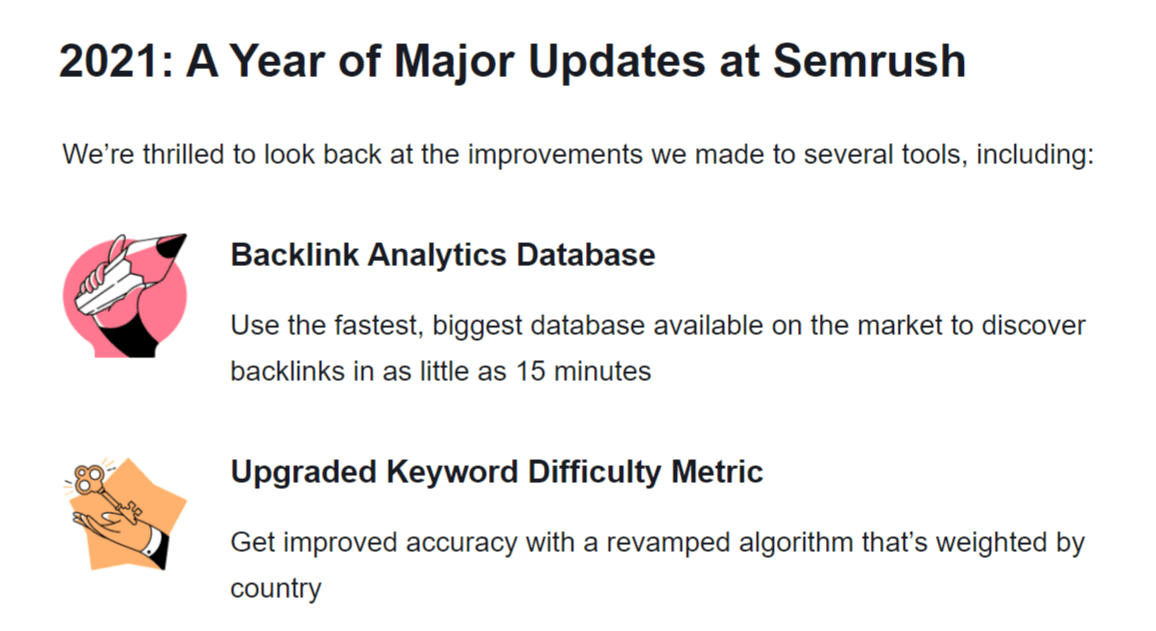
Company updates are a great way to keep your audience engaged with your business. You can easily craft the perfect company update email by selecting and customizing one of our business newsletter templates. You can try them out simply by creating a Moosend account.
Onboarding Campaigns
Subject line: Welcome to DocuSign, Ioannis! Let’s get started.
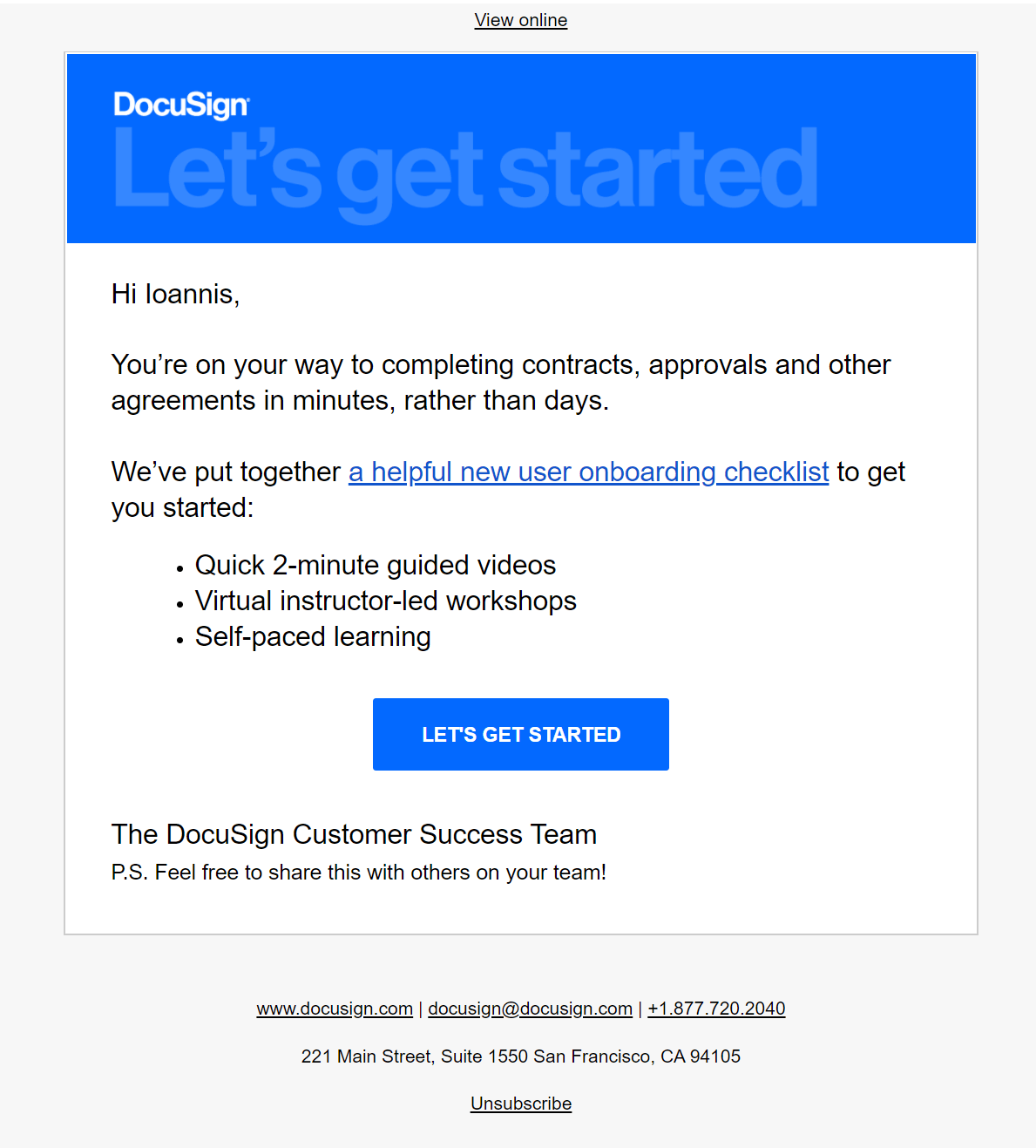
Welcoming your new subscribers is a great way to make a lasting first impression. But is this enough to turn them into customers and advocates of your business? Well, no. To make them stay, you need to show them how they can get the most out of your product/service.
In the above example, DocuSign has created a simple campaign to help new users get started. The copy is straightforward and explanatory while the bullets make the entire message easier to digest. Moreover, the blue CTA stands out in the design, promoting action and helping new customers take the necessary steps to success.
Creating an onboarding sequence will further increase your chances of having engaged users and boost your enterprise email marketing strategy.
Lead Nurturing Emails
Subject line: Reviews that speak to you
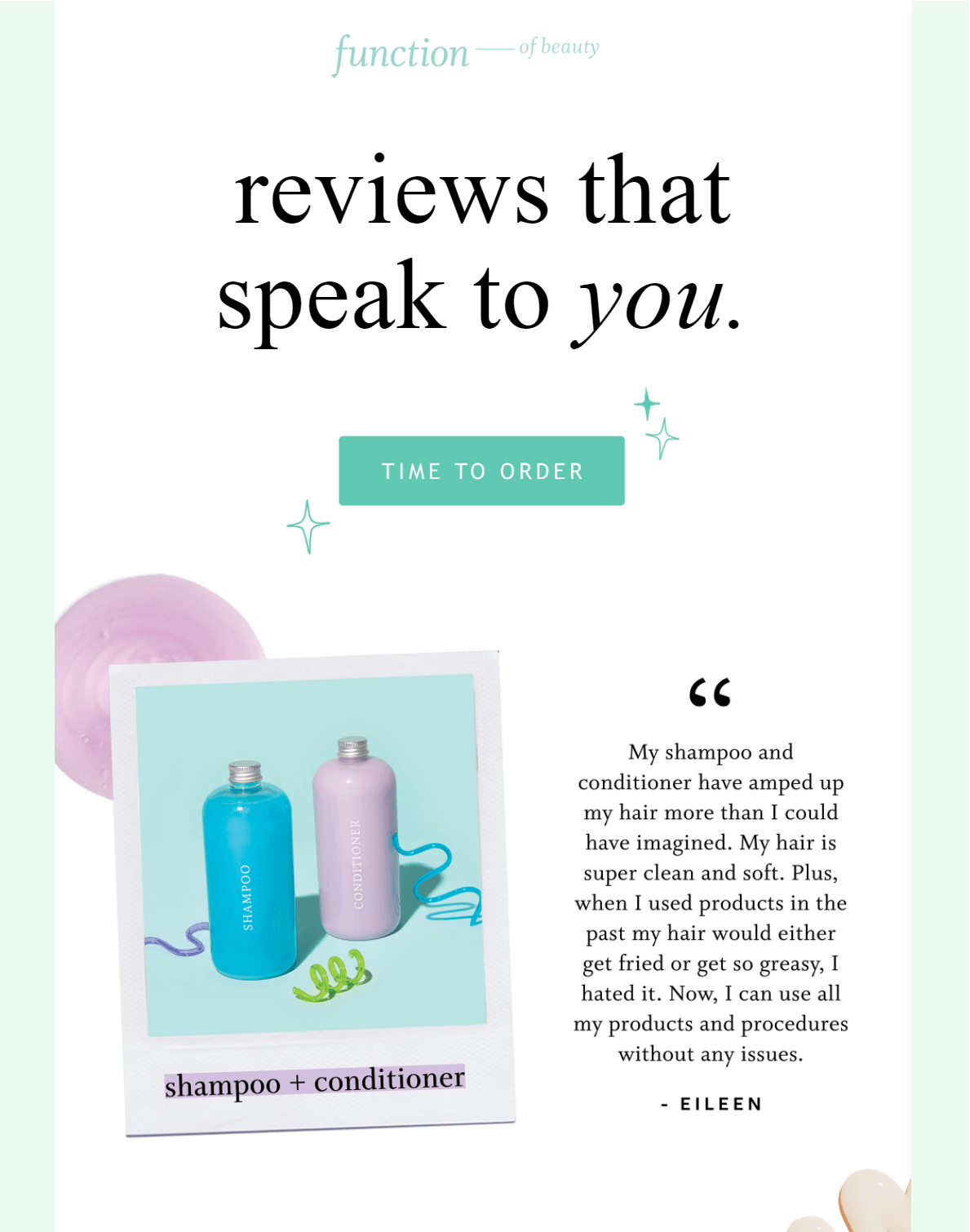
Nurturing your leads is essential to get them to act. One of the best ways to do it is to take advantage of social proof to show them that your product actually works. Function of Beauty, in this case, infuses its campaigns with customer testimonials and reviews to promote action.
Using high-quality product images and beautiful colors, the above newsletter example is perfect for encouraging customers to click on the CTA button and place an order. Lead nurturing campaigns can vary based on your goal. You can easily craft promotional or educational content to get them one step closer to conversion.
Whatever you choose, make sure to use social proof. It’s your best weapon to show them how their peers perceive your brand and your products.
Pro tip: Nurturing your leads is a great way to get them to act. Nevertheless, if you want to improve the effectiveness of your messages, you need to take advantage of lead scoring to discover whether a lead is worth your time and effort.
Transactional Messages
Subject line: Thank you for your order!
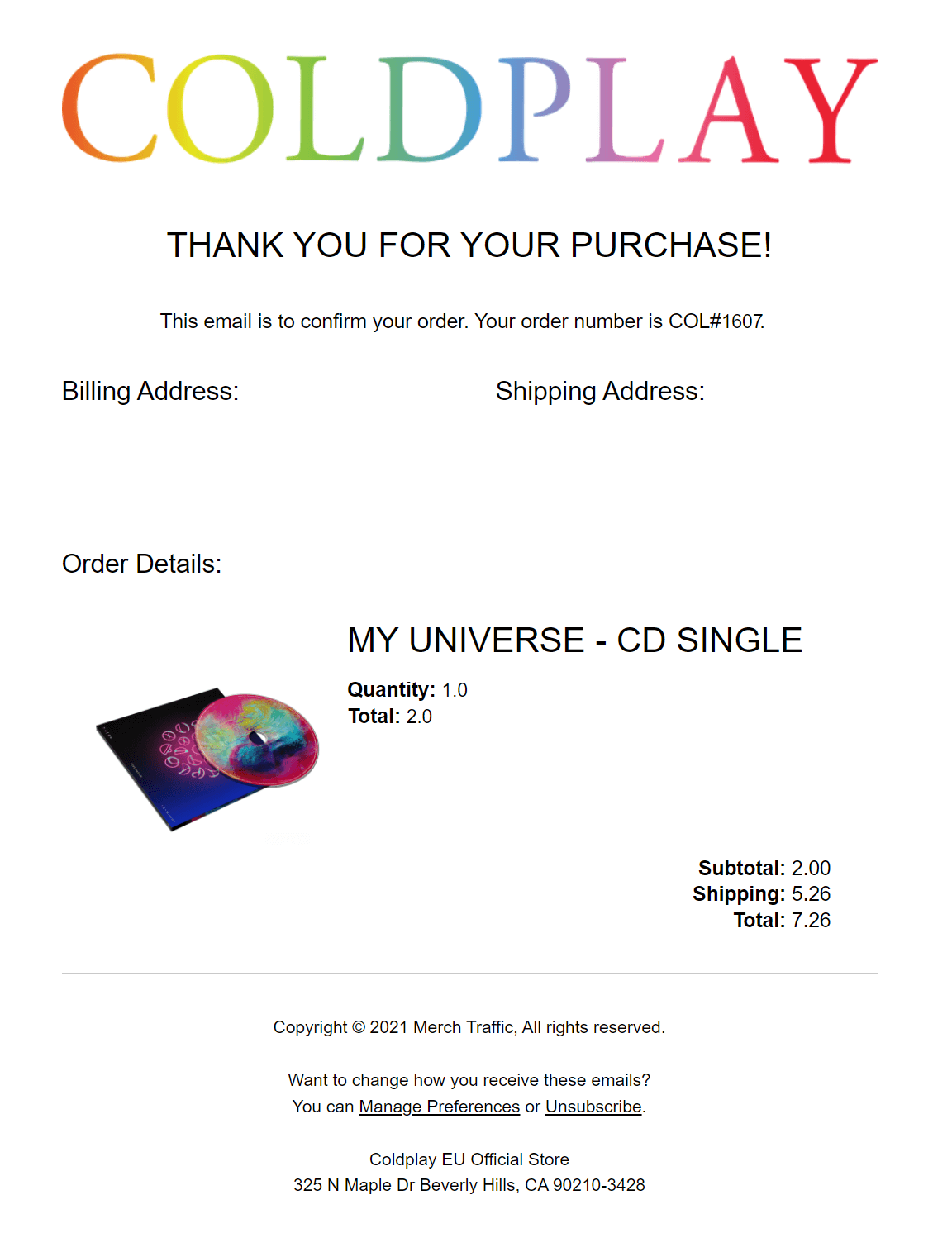
Transactional emails are a must for every business. Here, Coldplay has created a beautiful order confirmation message for its customers. As you can see, it takes advantage of white space to make it more straightforward and uses the band’s logo to add a bit of color.
Furthermore, the email includes the product image, the quantity, and the price to show the customer that everything went smoothly during the purchase stage.
Coldplay’s example is an efficient transactional email you can also use to show your audience a summary of their orders. To send transactional campaigns, you need an SMTP server. If you want a service that allows you to send unlimited campaigns like the above, you can register for Moosend and get the plan that suits your needs.
7. Automate Your Marketing Process
Last but not least, marketing automation is one of the most important tools that businesses can use to streamline their marketing efforts. By automating your campaigns you will achieve two things.
Firstly, you will save valuable time, which is absolutely essential to allow you to focus on more pressing tasks. Secondly, using automated workflows will let you target your audience with content tailored to their needs. And the best part is that you will do that the moment they need it the most.
Now, to automate your campaigns, you need a marketing automation tool. Most ESPs will offer you the option along with their email builder. Nevertheless, choosing the right marketing automation software is of paramount importance to make it work.

For instance, Mailchimp’s automation feature may be on the advanced side, but it doesn’t offer a visual editor which may be a problem for some.
After you find the one that suits your needs, you can start creating your own automated workflows or choose from the available recipes. Then, you can start creating drip campaigns to target your audience with the right content at the right time, such as:
- Welcome/onboarding emails
- Re-engagement sequences
- Upsell/Cross-sell series
- Special offer reminders
What You Can Do Next?
Above, we took a look at the basic steps you need to follow to structure your enterprise email marketing strategy. The good news is these are enough to start engaging your audience. The bad news is that email marketing is a process that requires a few more steps to give you maximal results:
- Create an effective email sending schedule based on your open rate and engagement data.
- Keep your email lists clean by performing regular checks for better deliverability.
- Perform A/B Testing to improve your message efficiency and find what your audience likes most.
- Integrate your email marketing with other channels like social media and SMS marketing to target your audience better.
- Infuse your email campaigns with storytelling elements to improve the customer experience.
These are only a few more things you can do to upgrade your email marketing strategy.
For even better results, make sure to check our email marketing best practices to make the most out of this digital marketing strategy for your large business.
Email Marketing Strategy For Large Businesses
Creating an effective enterprise email marketing strategy for your large business will help you tap into the benefits of this powerful digital marketing channel.
To get started, you need to get the right tools, build your email list, segment your audience and personalize your messages, choose the right newsletters, and automate your processes. Of course, don’t forget to collect data to optimize your tactics for better results!
Now you can start building your email marketing strategy from the ground up. And if you need a great tool to support your efforts, you can try Moosend’s email marketing automation software to make things simpler.
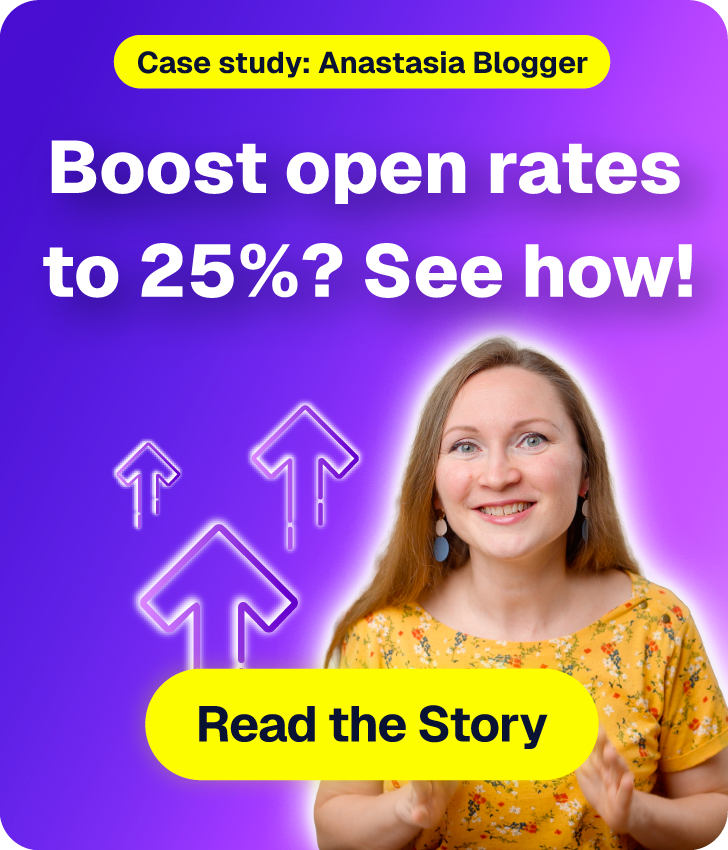
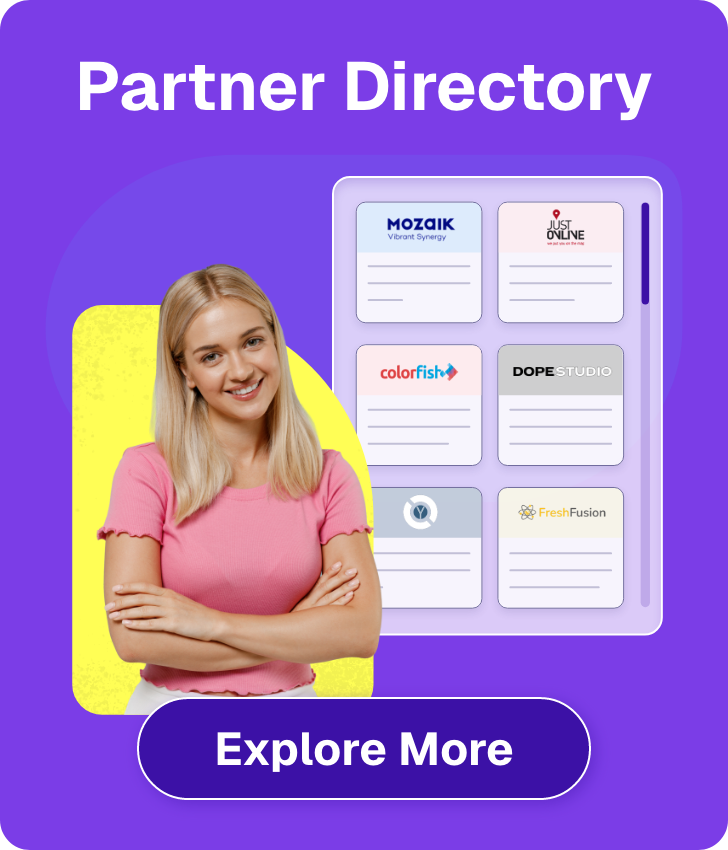

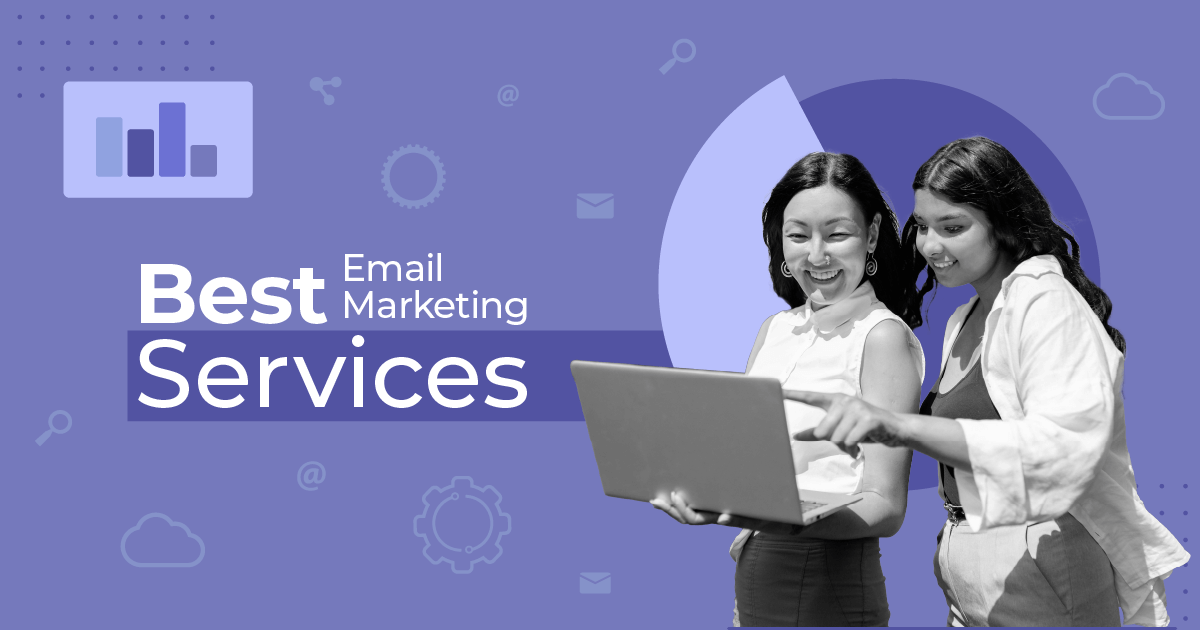
 Published by
Published by
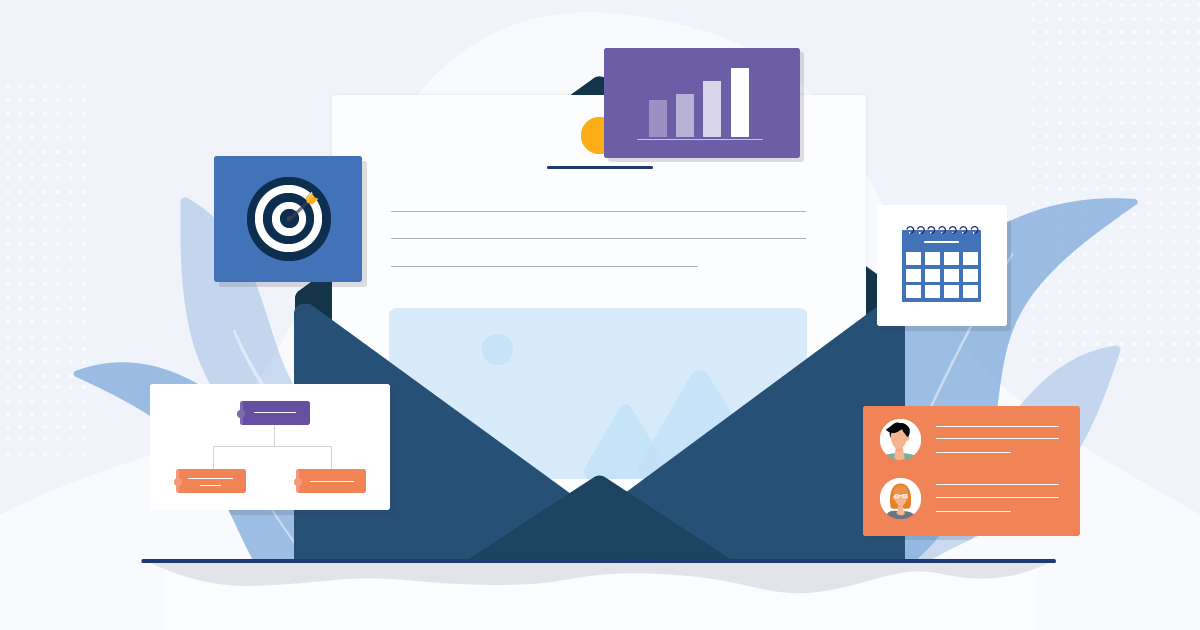
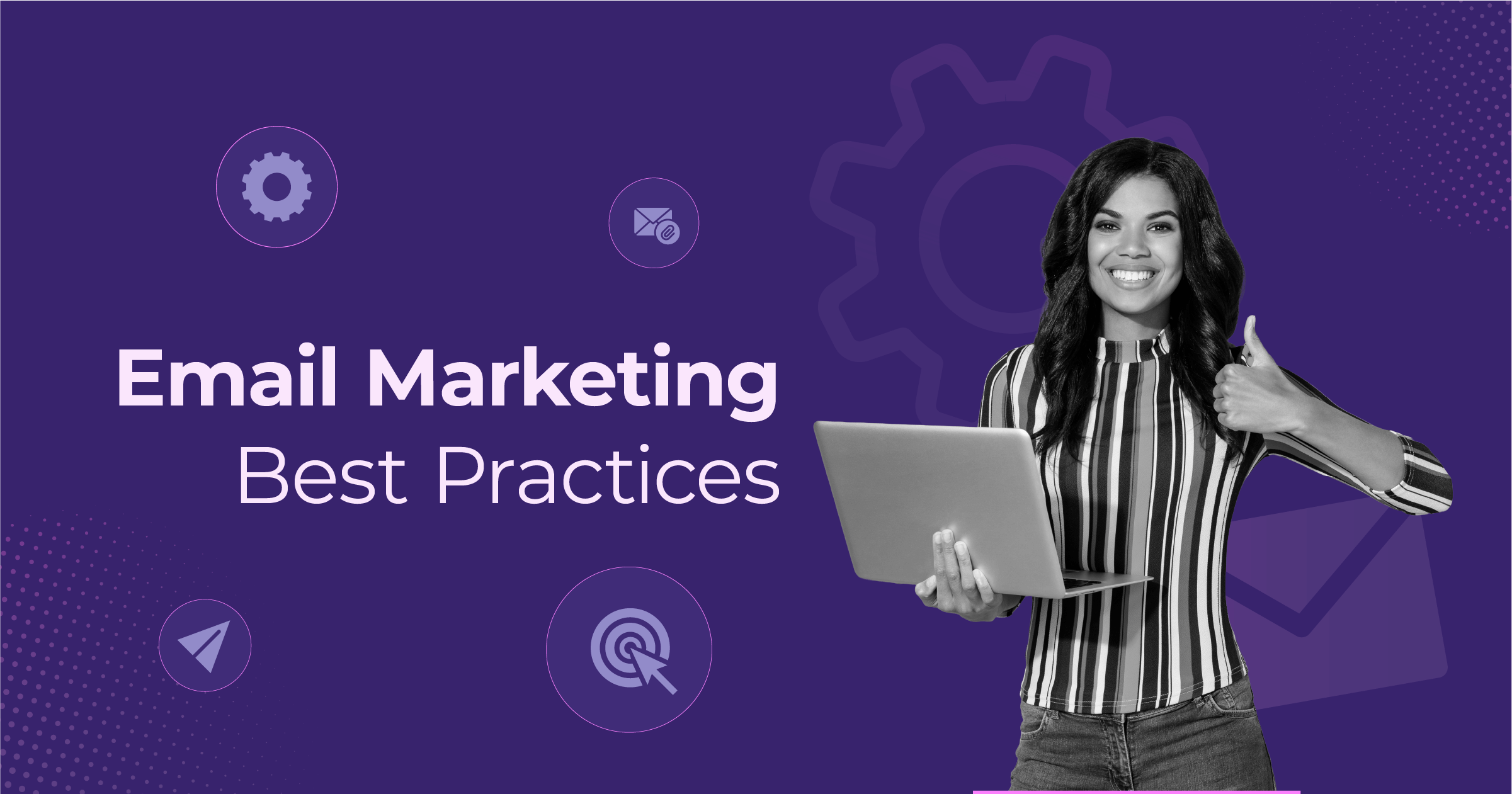
 Published by
Published by